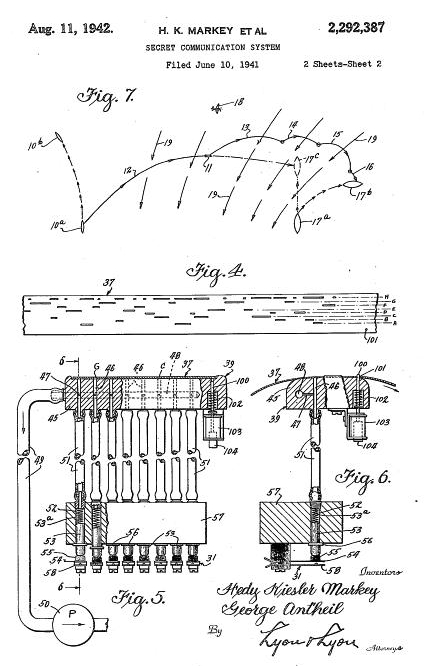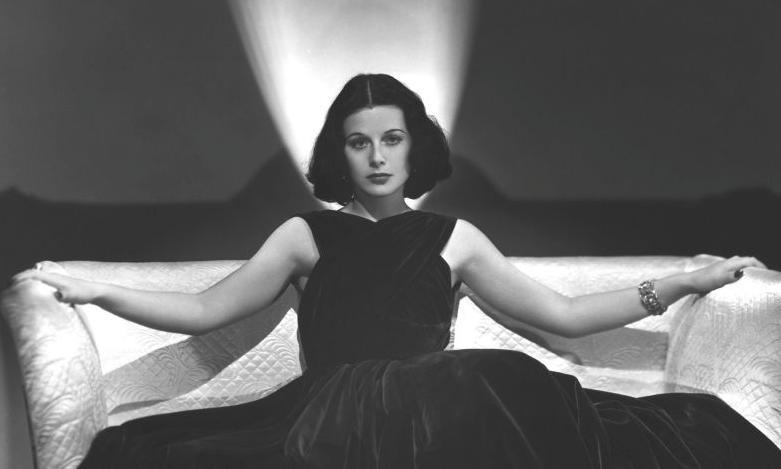The woman who made wireless communication possible🙋📡 . - La mujer que hizo posible la comunicación inalambrica. 🙋📡

The solutions that modern computing offers us to make the connection between computers viable have among their inventors a particular case of female beauty and intelligence that marked a before and after in the history of humanity and that opened the doors to the call "Information age".
 )
) Hedy Lamarr, the "most beautiful woman in the history of cinema" and the inventor of the communication system called "spread spectrum transmission technique" on which all the wireless technologies available to us are based today 📡
"Any woman can look glamorous, all she has to do is sit still and look stupid" -Hedy Lamarr
The field of communications was critical, and remote control weapons guidance systems using radio signals were being tested, but governments were reluctant to manufacture guided missiles for fear that the control signals would be intercepted by the enemy. Hedy proposed a solution that was as simple as it was effective: transmitting the messages by dividing them into small parts, each of which would be transmitted by changing frequency following a pseudo-random pattern. The proposed procedure is known as “frequency hopping spread spectrum transmission”, Frequency Hopping Spread Spectrum (FHSS), and its main advantage is that the signals are highly immune to noise and interference and difficult to recognize and intercept.
Accompanied by George Antheil, an American pianist and composer who, in 1923, had premiered her work Ballet Mécanique, in which she synchronized 16 pianolas wirelessly, they developed a system that “worked” using two pianolas, one at the broadcast station and the other at the receiver and encoding the frequency jumps, and on June 10, 1941 they presented the patent application for a "Secret Communication System" that was granted to them on August 11, 1942, when the United States was already at war. The patent was intended for the specific application as a remote control of the rudder of a torpedo, and could be used for the transmission of sounds and spoken messages. In addition, as the number of channels available exceeded the necessary number, it was proposed that the surplus be used to create false transmissions designed to deceive the enemy.

The first application of the system took place during the Cuban missile crisis in 1962, where the US naval force used it for remote control of tracking buoys. Later it was used in some devices used in the Vietnam War (1964-1973) and in the North American satellite defense system (Milstar) in the 90's. Until the 80's it was not applied in civil engineering with the emergence of digital technology. Today, many voice and data oriented systems use spread spectrum systems (all wireless technologies available are based on random channel change) and more and more applications are being found in wireless data transmission.
Hedy was the absolute pioneer in this technique, but the honors and recognition were a long time coming. The rest of her personal life was not fortunate and she spent the last years of hers in her Miami mansion secluded from a world that celebrated the new applications of her invention without even naming her. When she was notified of the Pioneer Award in 1997, she simply commented "about time. That same year, she, along with Antheil, received the Bulbie Gnass Spirit of Achievement Award, known as the “Oscars of Inventing,” as well as an honorary distinction from the Milstar project. In October 1998, the Austrian Association of Inventors and Patent Holders awarded her the Viktor Kaplan Medal and, in the summer of 1999, the Kunsthalle in Vienna organized a tribute to the most unique actress and inventor of the 20th century.

She passed away on January 19, 2000. Her son fulfilled her wishes and half of her ashes covered the forests of her native Vienna. The other half was handed over to the Viennese town hall to be buried in a memorial, but these, in the umpteenth no to her figure, asked 10,000 euros for the tombstone. Finally, on November 7, 2014, she received a well-deserved tribute in Vienna and, posthumously, she was inducted into the National Inventors Hall of Fame that same year.
Hedy Lamarr had been born on November 9; therefore, every year on that date the International Inventor's Day is celebrated in her honor.


Las soluciones que nos brinda la computación moderna para viabilizar la conexión entre equipos tiene entre sus inventores un caso particular de belleza e inteligencia femeninas que marcarcaron un antes y un después en la historia de la humanidad y que abrió las puertas a la llamada "Era de la información".

Hedy Lamarr, la “mujer más bella de la historia del cine” y la inventora del sistema de comunicaciones denominado “técnica de transmisión en el espectro ensanchado” en el que se basan todas las tecnologías inalámbricas que disponemos en la actualidad 📡
“Cualquier mujer se puede ver glamurosa, todo lo que tiene que hacer es quedarse quieta y verse como estúpida” - Hedy Lamarr
El ámbito las comunicaciones resultaba crítica, y se estaban experimentando sistemas de guiado de armas por control remoto mediante señales de radio, pero los gobiernos eran reticentes a fabricar misiles teledirigidos por miedo a que las señales de control fuesen interceptadas por el enemigo. Hedy propuso una solución tan simple como eficaz: transmitir los mensajes fraccionándolos en pequeñas partes, cada una de las cuales se transmitiría cambiando de frecuencia siguiendo un patrón pseudoaleatorio. El procedimiento propuesto se conoce como “transmisión en espectro ensanchado por salto de frecuencia”, Frequency Hopping Spread Spectrum (FHSS) en inglés, y su principal ventaja es que las señales son altamente inmunes a ruidos e interferencias y difíciles de reconocer e interceptar.
Acompañada por George Antheil, pianista y compositor norteamericano que, en 1923, había estrenado su obra Ballet Mécanique, en la cual sincronizaba sin cables 16 pianolas, desarrollaron un sistema que “funcionaba” empleando dos pianolas, una en la estación emisora y otra en la receptora y codificando los saltos de frecuencia, y el 10 de junio de 1941 presentaron la solicitud de patente para un “Secret Communication System” que les fue concedida el 11 de agosto de 1942, cuando Estados Unidos ya estaba en guerra. La patente estaba pensada para la aplicación concreta como control remoto del timón de un torpedo, y podía emplearse para la transmisión de sonidos y mensajes hablados. Además, como el número de canales disponible superaba el número necesario, se proponía que los sobrantes fuesen empleados para para crear falsas transmisiones destinadas a engañar al enemigo.

La primera aplicación del sistema tuvo lugar durante la crisis de los misiles de Cuba en 1962, donde la fuerza naval estadounidense lo empleó para el control remoto de boyas rastreadoras. Posteriormente se empleó en algunos dispositivos utilizados en la guerra del Vietnam (1964-1973) y en el sistema norteamericano de defensa por satélite (Milstar) en los años 90. Hasta la década de los 80 no se aplicaría en ingeniería civil con la irrupción de la tecnología digital. En la actualidad, muchos sistemas orientados a voz y datos emplean sistemas de espectro ensanchado (todas las tecnologías inalámbricas de que disponemos se basan en el cambio aleatorio de canal) y cada vez se encuentran más aplicaciones en la transmisión de datos sin cable.
Hedy fue la pionera absoluta en esta técnica, pero los honores y el reconocimiento tardaron, y mucho, en llegar. El resto de su vida personal no fue afortunada y pasó sus últimos años en su mansión de Miami apartada de un mundo que celebraba las nuevas aplicaciones de su invención sin siquiera nombrarla. Cuando le comunicaron la concesión del Pioneer Award en 1997, simplemente comentó “ya era hora”. Ese mismo año, junto a Antheil, recibió el Bulbie Gnass Spirit of Achievement Award, conocido como el “Oscars of Inventing”, así como una distinción honorífica del proyecto Milstar. En Octubre de 1998, la Asociación Austriaca de Inventores y Titulares de Patentes le concedió la medalla Viktor Kaplan y, en el verano de 1999, el Kunsthalle de Viena organizó un homenaje a la actriz e inventora más singular del siglo XX.

Falleció el 19 de enero de 2000. Su hijo cumplió sus deseos y la mitad de sus cenizas cubrió los bosques de su Viena natal. La otra mitad fue entregada al consistorio vienés para que las enterrasen en un memorial, pero estos, en el enésimo ninguneo a su figura, pidieron 10.000 euros por la lápida. Finalmente, el 7 de noviembre de 2014, recibió un merecido homenaje en Viena y, a título póstumo, fue incluida en el National Inventors Hall of Fame ese mismo año.
Hedy Lamarr había nacido el 9 de noviembre; por eso, cada año en esa fecha se celebra ese día el Día Internacional del Inventor en su honor.

Congratulations @linkxdx! You have completed the following achievement on the Hive blockchain and have been rewarded with new badge(s) :
Your next target is to reach 200 upvotes.
You can view your badges on your board and compare yourself to others in the Ranking
If you no longer want to receive notifications, reply to this comment with the word
STOPSupport the HiveBuzz project. Vote for our proposal!